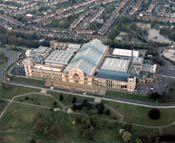Alexandra Palace,London
 The Palm Court of Alexandra Palace
The Palm Court of Alexandra Palace

 The Palm Court of Alexandra Palace
The Palm Court of Alexandra Palace


 Since 604AD this is the fourth Cathedral to occupy this spot overlooking the City of London. It was designed by Sir Christopher Wren and built between 1675 and 1710 after the previous building had been destroyed in the Great Fire of London (1666). There are many existing London churches built to designs by Wren who had started his career as a mathematician and scientist and finished it as an astronomer. The most fascinating thing about this buiding is the dome, which weighs 65,000 tons and presented an engineering problem for Wren because a dome will exert tremendous outward as well as downward pressure. The 'secret' of how it stays in place is a huge chain around the outside of the dome (covered in Portland stone, the building material of the cathedral) which grips the dome to restrain outward movement.
Since 604AD this is the fourth Cathedral to occupy this spot overlooking the City of London. It was designed by Sir Christopher Wren and built between 1675 and 1710 after the previous building had been destroyed in the Great Fire of London (1666). There are many existing London churches built to designs by Wren who had started his career as a mathematician and scientist and finished it as an astronomer. The most fascinating thing about this buiding is the dome, which weighs 65,000 tons and presented an engineering problem for Wren because a dome will exert tremendous outward as well as downward pressure. The 'secret' of how it stays in place is a huge chain around the outside of the dome (covered in Portland stone, the building material of the cathedral) which grips the dome to restrain outward movement.  Inside view of the dome.
Inside view of the dome.The Whispering Gallery - the most famous of the galleries and the only one on the inside, has been described as one of the most amazing acoustical oddities in the world, because if you talk in a loud whisper facing the wall on one side you can be heard clearly on the diagonally opposite side.
St Paul’s is the cathedral of the Diocese of London and is the nations spirtual focal point. The funeral services of Nelson, Wellington and Churchill were held there as was the celebration of Queen Victoria's Jubilee, Charle's and Diana's Wedding and the memorial service for 9/11.
Sir Christopher Wren is also buried there, in a very plain grave. On the wall at the head of his tomb is a plain inscription, in Latin, arranged by his son. It translates as If you seek his monument, look around you. Wren himself had not wanted a memorial at all.
 Well, OK. Homer isn't exactly the hero type but I want to celebrate The Simpsons in general and Homer in particular. As Bart Simpson once said of Krusty, it's "funny on so many levels". The Simpsons seems to be a format in which it's creators can super-impose all sorts of pastiches of popular culture but you can still watch an episode in ignorance of that and enjoy the humour that is both visual (cartoon slapstick) and cerebral (dialogue). There is a huge company of background characters that can be bought out as required to suit any situation. Krusty the Klown, serves as the stereotypical cynical showbiz type and the Comic Book Shop Guy is the sarcastic self-delusional nerd but Homer is the real star. I think there's a little bit of Homer in every man's character. Blimey.
Well, OK. Homer isn't exactly the hero type but I want to celebrate The Simpsons in general and Homer in particular. As Bart Simpson once said of Krusty, it's "funny on so many levels". The Simpsons seems to be a format in which it's creators can super-impose all sorts of pastiches of popular culture but you can still watch an episode in ignorance of that and enjoy the humour that is both visual (cartoon slapstick) and cerebral (dialogue). There is a huge company of background characters that can be bought out as required to suit any situation. Krusty the Klown, serves as the stereotypical cynical showbiz type and the Comic Book Shop Guy is the sarcastic self-delusional nerd but Homer is the real star. I think there's a little bit of Homer in every man's character. Blimey. I've just seen on the BBC (so it must be true) that John Wells, Professor of Phonetics at the University of London, has backed up claims by dairy farmers that cows "moo with regional accents"! This was noticed by members of the West Country Farmhouse Cheesemakers group, who put it down to the close bond between farmer and cow. Their claim that the cows mooed with a Somerset 'twang' has been verified. Prof. Wells said "This phenomena is well attested in birds. You find distinct chirping accents in the same species around the country. This could also be true of cows. In small populations such as herds you would encounter identifiable dialectical variations which are most affected by the immediate peer group."
I've just seen on the BBC (so it must be true) that John Wells, Professor of Phonetics at the University of London, has backed up claims by dairy farmers that cows "moo with regional accents"! This was noticed by members of the West Country Farmhouse Cheesemakers group, who put it down to the close bond between farmer and cow. Their claim that the cows mooed with a Somerset 'twang' has been verified. Prof. Wells said "This phenomena is well attested in birds. You find distinct chirping accents in the same species around the country. This could also be true of cows. In small populations such as herds you would encounter identifiable dialectical variations which are most affected by the immediate peer group."MICHEL DE MONTAIGNE (1533-1592)
Montaigne was born in Bordeaux, France, the son of a wealthy Catholic landowner & lawyer and a Spanish Jewish mother who was bought up as a Protestant. He virtually invented the essay as a form of writing and he used himself as a subject by means of searingly honest introspection. His writings were originally seen as self-indulgent but he was a strong influence on Shakespeare, Nietzsche, Rousseau and particularly Descartes.
What really draws my attention to him is the broad range of subjects that he wrote about and the very modern style that the essays still seem to have. They are very easy and rewarding to read on topics such as "On the Power of the Imagination" which detours for an hilarious discussion of farting before returning to it's stated topic. (Added 27th August: He was classically educated and his works are peppered with Latin quotations and references, All translated, of course, but it is worth persevering.) He was modest and unassuming, even pondering at one time to consider whether or not, when he played with his cat, it was her playing with him. To give an idea of his scope here are some of his essay titles: "Of Drunkeness", "Of Cannibals", "Of Thumbs", "That To Study Philosophy IsTo Learn To Die", "How we weepe and laugh at one selfe-same thing" and so on.
 A row of cottages in Farningham with one house almost hidden by flowers.
A row of cottages in Farningham with one house almost hidden by flowers.Kent is known as 'The Garden of England' being full of fruit farms, hop fields and garden centres. I came across this row of cottages today and the sight of it is overwhelming with one of the dwellings almost completely hidden by flowers. Farningham is a picturesque village not far from London and it has an interesting history. It's population was 561 in 1821, 1328 in 1901 and remains about the same as that today. It is on the River Darent and was a neolithic and, later, a Roman settlement. (See my post on St Albans.) Several Roman Villas have been excavated nearby and archeologists have identified a neolithic footpath that passes through the Darent Valley. Charles Dickens used to fish for trout in the Darent.
Farningham Parish Church. 13th Century
Farningham is mentioned in the Domesday Book which was compiled by William the Conqueror and completed in 1086. The church pictured above was started in 1240 with the tower being added in the 15th century. By the 19th century there were six stage-coaches per day stopping in Farningham which had become a thriving community. Many of it's present day structures date from the 18th and 19th centuries.
 In 1996 Michael Johnson become the first man to win the 200m and the 400m in the same Olympics. In fact, no other athlete has won a 200m as well as a 400m Olympic Gold Medal. He was also the first man to retain the 400m title, at Sydney in 2000. He still holds the world records for both events and he had a spell between 1989 and 1997 when he won 58 consecutive 400m races.
In 1996 Michael Johnson become the first man to win the 200m and the 400m in the same Olympics. In fact, no other athlete has won a 200m as well as a 400m Olympic Gold Medal. He was also the first man to retain the 400m title, at Sydney in 2000. He still holds the world records for both events and he had a spell between 1989 and 1997 when he won 58 consecutive 400m races. Southend-on-Sea is on the Thames Estuary in Essex about 35 miles from London and is east London's favourite place for a day-trip to the sea. I went there yesterday, with my daughter Ruth and her twins Jacob & Zack, to the Adventure Island playground. The boys were ecstatic and had a great time although they spent much of the time walking around with their hands over their ears because they didn't like the noise which was mostly generated by the screams of teenaged girls on the roller-coaster.
Southend-on-Sea is on the Thames Estuary in Essex about 35 miles from London and is east London's favourite place for a day-trip to the sea. I went there yesterday, with my daughter Ruth and her twins Jacob & Zack, to the Adventure Island playground. The boys were ecstatic and had a great time although they spent much of the time walking around with their hands over their ears because they didn't like the noise which was mostly generated by the screams of teenaged girls on the roller-coaster. 
 For me, it was paradise to spend a day with my daughter and grandsons and when Zack said, unpromted, "I love you Grandad" my day was complete!
For me, it was paradise to spend a day with my daughter and grandsons and when Zack said, unpromted, "I love you Grandad" my day was complete!

 William Morris House, LLoyd Park, Walthamstow, London
William Morris House, LLoyd Park, Walthamstow, LondonWilliam Morris, the founder of the Arts & Crafts movement lived in this house for twelve years in the mid-nineteenth century. Now it is a gallery and museum set into Lloyd Park in Walthamstow in London. The house is built in classic eighteenth century Georgian style. Georgian architecture is characterized by proportion and balance; as you can see this building is symmetrical. The ratio between the width and height of the windows would have been significant to engender the sense of harmony. Also it was usual to have features from one or other of the classical orders of architecture. You can't see it very well in my picture but there are two columns in the Corinthian style supporting the classical porticoed front door.

This garden is at the back of the house and is a part of Lloyd Park, now a public space but once part of the extensive grounds of the house. There is a garden hose-pipe ban at present in the Thames Water area around most of London. I think it would take a lot of watering cans to keep the lawn looking so good - compare it with the grass at the front in first picture!
This third picture is of the ornamental moat in the former grounds of the house. The bird near the top of the picture is a moorhen, easily identified by it's red and yellow bill. Just below her are two juvenile moorhens and in the foreground the ubiquitous Canada Goose. If you are interested in learning more about William Morris click here. I am sure he was a very worthy man but I find him, unlike his former home, rather dull.
 Sonny is 18 months old and a very bright little boy. He laughs, chuckles and smiles nearly all of the time. This photo catches him in a rare (relatively) serious moment. He loves to sing and play with his toy cars. In fact he will play with anything and is capable of amusing himself with a cardboard box for half an hour.
Sonny is 18 months old and a very bright little boy. He laughs, chuckles and smiles nearly all of the time. This photo catches him in a rare (relatively) serious moment. He loves to sing and play with his toy cars. In fact he will play with anything and is capable of amusing himself with a cardboard box for half an hour.